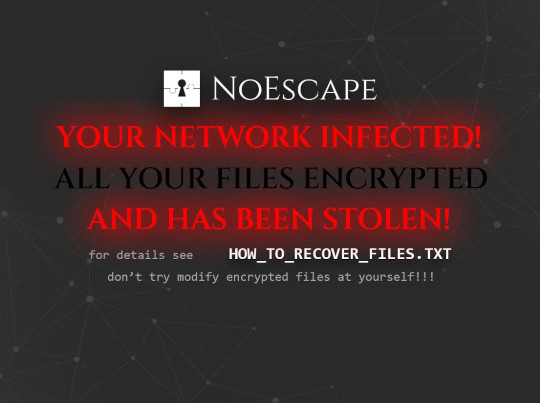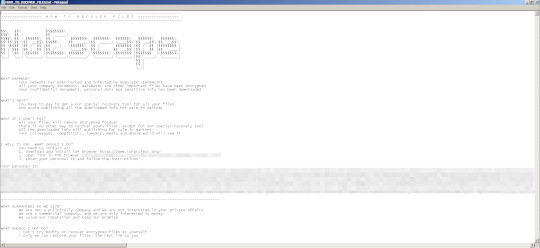Ransom.Win32.NOESCAPE.THFOEBC
Ransom:Win32/NoEscape.MKV!MTB (MICROSOFT)
Windows


Threat Type: Ransomware
Destructiveness: No
Encrypted: Yes
In the wild: Yes
OVERVIEW
This Ransomware arrives on a system as a file dropped by other malware or as a file downloaded unknowingly by users when visiting malicious sites.
It encrypts files found in specific folders. It drops files as ransom note. It avoids encrypting files with the following file extensions.
TECHNICAL DETAILS
Arrival Details
This Ransomware arrives on a system as a file dropped by other malware or as a file downloaded unknowingly by users when visiting malicious sites.
Installation
This Ransomware drops the following copies of itself into the affected system:
- %Application Data%\{Malware File Name}.exe
(Note: %Application Data% is the current user's Application Data folder, which is usually C:\Documents and Settings\{user name}\Application Data on Windows 2000(32-bit), XP, and Server 2003(32-bit), or C:\Users\{user name}\AppData\Roaming on Windows Vista, 7, 8, 8.1, 2008(64-bit), 2012(64-bit) and 10(64-bit).)
It adds the following processes:
- wmic SHADOWCOPY DELETE /nointeractive
- wbadmin DELETE SYSTEMSTATEBACKUP -deleteOldest
- wbadmin DELETE SYSTEMSTATEBACKUP -keepVersions:0
- wbadmin DELETE BACKUP -deleteOldest
- wbadmin DELETE BACKUP -keepVersions:0
- vssadmin Delete Shadows /All /Quiet
- bcdedit /set {default} recoveryenabled No
- bcdedit /set {default} bootstatuspolicy ignoreallfailures
- cmd /c wmic SHADOWCOPY DELETE /nointeractive
- cmd /c wbadmin DELETE SYSTEMSTATEBACKUP -deleteOldest
- cmd /c wbadmin DELETE SYSTEMSTATEBACKUP -keepVersions:0
- cmd /c wbadmin DELETE BACKUP -deleteOldest
- cmd /c wbadmin DELETE BACKUP -keepVersions:0
- cmd /c vssadmin Delete Shadows /All /Quiet
- cmd /c bcdedit /set {default} recoveryenabled No
- cmd /c bcdedit /set {default} bootstatuspolicy ignoreallfailures
- cmd /c bcdedit /set safeboot network
It adds the following mutexes to ensure that only one of its copies runs at any one time:
- Global\{GUID}
Autostart Technique
This Ransomware adds the following registry entries to enable its automatic execution at every system startup:
HKEY_CURRENT_USER\SOFTWARE\Microsoft\
Windows NT\CurrentVersion\Winlogon
Shell = explorer.exe,%Application Data%\[Malware File Name}.exe
Other System Modifications
This Ransomware adds the following registry entries:
HKEY_LOCAL_MACHINE\SOFTWARE\Microsoft\
Windows\CurrentVersion\Policies\
System
EnableLUA = 0
(Note: The default value data of the said registry entry is 1.)
HKEY_LOCAL_MACHINE\SOFTWARE\Microsoft\
Windows\CurrentVersion\Policies\
System
ConsentPromptBehaviorAdmin = 0
(Note: The default value data of the said registry entry is 5.)
HKEY_LOCAL_MACHINE\SOFTWARE\Microsoft\
Windows\CurrentVersion\Policies\
System
EnableLinkedConnections = 1
It sets the system's desktop wallpaper to the following image:
- %Application Data%\wallpaper.jpg

Process Termination
This Ransomware terminates the following services if found on the affected system:
- Culserver
- DefWatch
- GxBlr
- GxCIMgr
- GxCVD
- GxFWD
- GxVss
- QBCFMonitorService
- QBIDPService
- RTVscan
- SavRoam
- VMAuthdService
- VMUSBArbService
- VMnetDHCP
- VMwareHostd
- backup
- ccEvtMgr
- ccSetMgr
- dbeng8
- dbsrv12
- memtas
- mepocs
- msexchange
- msmdsrv
- sophos
- sql
- sqladhlp
- sqlagent
- sqlbrowser
- sqlservr
- sqlwriter
- svc$
- tomcat6
- veeam
- vmware-converter
- vmware-usbarbitator64
- vss
It terminates the following processes if found running in the affected system's memory:
- 360doctor
- 360se
- Culture
- Defwatch
- GDscan
- MsDtSrvr
- QBCFMonitorService
- QBDBMgr
- QBIDPService
- QBW32
- RAgui
- RTVscan
- agntsvc
- agntsvcencsvc
- agntsvcisqlplussvc
- anvir
- anvir64
- apache
- axlbridge
- backup
- ccleaner
- ccleaner64
- dbeng50
- dbsnmp
- encsvc
- excel
- far
- fdhost
- fdlauncher
- httpd
- infopath
- isqlplussvc
- java
- kingdee
- msaccess
- msftesql
- mspub
- mydesktopqos
- mydesktopservice
- mysqld-nt
- mysqld-opt
- mysqld
- ncsvc
- ocautoupds
- ocomm
- ocssd
- onedrive
- onenote
- oracle
- outlook
- powerpnt
- procexp
- qbupdate
- sqbcoreservice
- sql
- sqlagent
- sqlbrowser
- sqlmangr
- sqlserver
- sqlservr
- sqlwriter
- steam
- supervise
- synctime
- taskkill
- tasklist
- tbirdconfig
- thebat
- thunderbird
- tomcat
- tomcat6
- u8
- ufida
- visio
- wdswfsafe
- winword
- wordpad
- wuauclt
- wxServer
- wxServerView
- xfssvccon
Information Theft
This Ransomware gathers the following data:
- Computer Name
- Host Name
- Machine GUID
- User Language
- OEM Information
- Disk Drive Information
Other Details
This Ransomware does the following:
- It empties Recycle Bin of all drives.
- It dismounts disk images found in the system by running these processes:
- powershell Dismount-DiskImage -ImagePath {Full Path of Disk Image}
- cmd /c powershell Dismount-DiskImage -ImagePath {Full Path of Disk Image}
- It is capable of rebooting the system into safe mode with networking.
It accepts the following parameters:
- -safe (This parameter reboots the system into safe mode with networking before encrypting files).
Ransomware Routine
This Ransomware encrypts files found in the following folders:
- {Exchange Install Path}\Mailbox
- %Program Files%\Microsoft SQL Server
- %Program Files%\Microsoft\Exchange Server
- %Program Files%\mysql
(Note: %Program Files% is the default Program Files folder, usually C:\Program Files in Windows 2000(32-bit), Server 2003(32-bit), XP, Vista(64-bit), 7, 8, 8.1, 2008(64-bit), 2012(64-bit) and 10(64-bit) , or C:\Program Files (x86) in Windows XP(64-bit), Vista(64-bit), 7(64-bit), 8(64-bit), 8.1(64-bit), 2008(64-bit), 2012(64-bit) and 10(64-bit).)
It avoids encrypting files with the following strings in their file path:
- %Public%
- %ProgramData%
- %Program Files%
- %System Root%\Users\All Users
- %Windows%
- %Temp%
- %User Profile%\AppData
- %Application Data%
(Note: %Public% is the folder that serves as a repository of files or folders common to all users, which is usually C:\Users\Public in Windows Vista, 7, and 8.. %ProgramData% is a version of the Program Files folder where any user on a multi-user computer can make changes to programs. This contains application data for all users. This is usually C:\ProgramData on Windows Vista, 7, 8, 8.1, 2008(64-bit), 2012(64-bit) and 10(64-bit), or C:\Documents and Settings\All Users on Windows Server 2003(32-bit), 2000(32-bit) and XP.. %Program Files% is the default Program Files folder, usually C:\Program Files in Windows 2000(32-bit), Server 2003(32-bit), XP, Vista(64-bit), 7, 8, 8.1, 2008(64-bit), 2012(64-bit) and 10(64-bit) , or C:\Program Files (x86) in Windows XP(64-bit), Vista(64-bit), 7(64-bit), 8(64-bit), 8.1(64-bit), 2008(64-bit), 2012(64-bit) and 10(64-bit).. %System Root% is the Windows root folder, where it usually is C:\ on all Windows operating system versions.. %Windows% is the Windows folder, where it usually is C:\Windows on all Windows operating system versions.. %Temp% is the Windows temporary folder, where it usually is C:\Windows\Temp on all Windows operating system versions.. %User Profile% is the current user's profile folder, which is usually C:\Documents and Settings\{user name} on Windows 2000(32-bit), XP, and Server 2003(32-bit), or C:\Users\{user name} on Windows Vista, 7, 8, 8.1, 2008(64-bit), 2012(64-bit) and 10(64-bit).. %Application Data% is the current user's Application Data folder, which is usually C:\Documents and Settings\{user name}\Application Data on Windows 2000(32-bit), XP, and Server 2003(32-bit), or C:\Users\{user name}\AppData\Roaming on Windows Vista, 7, 8, 8.1, 2008(64-bit), 2012(64-bit) and 10(64-bit).)
It avoids encrypting files found in the following folders:
- AppData
- EFI
- Intel
- MSOCache
- Mozilla
- Program Files
- ProgramData
- Tor Browser
- Windows
- WINDOWS
- boot
- perflogs
- system volume information
- windows.old
It appends the following extension to the file name of the encrypted files:
- .EACBHCJFI
It drops the following file(s) as ransom note:
- %Desktop%\HOW_TO_RECOVER_FILES.txt
- {File Path of Encrypted Files}\HOW_TO_RECOVER_FILES.txt

It avoids encrypting files with the following file extensions:
- .exe
- .bat
- .bin
- .cmd
- .com
- .cpl
- .dat
- .dll
- .drv
- .hta
- .ini
- .lnk
- .lock
- .log
- .mod
- .msc
- .msi
- .msp
- .pif
- .prf
- .rdp
- .scr
- .shs
- .swp
- .sys
- .theme
SOLUTION
Step 1
Trend Micro Predictive Machine Learning detects and blocks malware at the first sign of its existence, before it executes on your system. When enabled, your Trend Micro product detects this malware under the following machine learning name:
- TROJ.Win32.TRX.XXPE50FFF070
Step 2
Before doing any scans, Windows 7, Windows 8, Windows 8.1, and Windows 10 users must disable System Restore to allow full scanning of their computers.
Step 3
Note that not all files, folders, and registry keys and entries are installed on your computer during this malware's/spyware's/grayware's execution. This may be due to incomplete installation or other operating system conditions. If you do not find the same files/folders/registry information, please proceed to the next step.
Step 4
Restart in Safe Mode
Step 5
Restore these modified registry values
Important:Editing the Windows Registry incorrectly can lead to irreversible system malfunction. Please do this only if you know how to or you can seek your system administrator's help. You may also check out this Microsoft article first before modifying your computer's registry.
- HKEY_LOCAL_MACHINE\SOFTWARE\Microsoft\Windows\CurrentVersion\Policies\System
- EnableLUA = 0
- EnableLUA = 1
- HKEY_LOCAL_MACHINE\SOFTWARE\Microsoft\Windows\CurrentVersion\Policies\System
- ConsentPromptBehaviorAdmin = 0
- ConsentPromptBehaviorAdmin = 5
Step 6
Delete this registry value
Important: Editing the Windows Registry incorrectly can lead to irreversible system malfunction. Please do this step only if you know how or you can ask assistance from your system administrator. Else, check this Microsoft article first before modifying your computer's registry.
- In HKEY_CURRENT_USER\Software\Microsoft\Windows NT\CurrentVersion\Winlogon
- Shell = explorer.exe,%Application Data%\[Malware File Name}.exe
- Shell = explorer.exe,%Application Data%\[Malware File Name}.exe
- In HKEY_LOCAL_MACHINE\SOFTWARE\Microsoft\Windows\CurrentVersion\Policies\System
- EnableLinkedConnections = 1
- EnableLinkedConnections = 1
Step 7
Search and delete these files
- %Application Data%\{Malware File Name}.exe
- %Application Data%\wallpaper.jpg
- %Desktop%\HOW_TO_RECOVER_FILES.txt
- {File Path of Encrypted Files}\HOW_TO_RECOVER_FILES.txt
Step 8
Restart in normal mode and scan your computer with your Trend Micro product for files detected as Ransom.Win32.NOESCAPE.THFOEBC. If the detected files have already been cleaned, deleted, or quarantined by your Trend Micro product, no further step is required. You may opt to simply delete the quarantined files. Please check this Knowledge Base page for more information.
Step 9
Reset your Desktop properties
Step 10
Restore encrypted files from backup.
Step 11
Scan your computer with your Trend Micro product to delete files detected as Ransom.Win32.NOESCAPE.THFOEBC. If the detected files have already been cleaned, deleted, or quarantined by your Trend Micro product, no further step is required. You may opt to simply delete the quarantined files. Please check the following Trend Micro Support pages for more information:
Did this description help? Tell us how we did.


